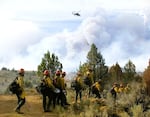The U.S. Forest Service is warning that hundreds of thousands of acres of forestlands across the Pacific Northwest are burning under record-breaking dry conditions this summer, without much relief in sight.
A heat wave, a series of lightning storms and human activity have combined to start more than 60 significant fires blazing across Oregon and Washington.

Firefighters head in to construct a fire line in triple-digit heat as a helicopter flies overhead to cool off hotspots with water on the Falls Fire, burning on the Malheur National Forest
Inciweb Falls Fire
In just 48 hours, firefighters counted more than 2,000 lightning strikes, and over the weekend half a million people were under fire danger warnings.
“This is really shaping up to be a monster fire year across the Pacific Northwest,” said U.S. Forest Service spokesperson Holly Krake.
The Deschutes National Forest, for example, has had 75 days without rain. And fire season runs for another three months.
“And there’s no rain forecasted in sight,” said Krake. “We are currently at the nation’s highest level of preparedness.”

Active wildfires in Oregon as of Wednesday afternoon.
Winston Szeto / OPB
All 17 national forests in Oregon and Washington are under campfire restrictions as human-caused ignitions account for 75% of wildfires in the Pacific Northwest.
On Monday, the Redmond Air Tanker Base hit the 1 million gallon mark for the use of wildfire retardant — the red stuff that drops out of air tankers as they fly over fire hotspots.
“That is the earliest that they have hit that 1 million gallon milestone in anyone’s recent memory,” Krake said.
While temperatures are expected to cool by the end of the week, the lack of moisture means the Pacific Northwest will have to stay under the nation’s highest level of preparedness for a while.
“It doesn’t get any higher than this,” Krake said. “So every crew, engine, dozer, aircraft, everything that is available we are using as much as we can.”
The U.S. Forest Service is bringing in resources from across the nation to fight the fires, including states as far away as Michigan, Wisconsin, Florida and North Carolina.
“We can’t prevent lightning, but we can prevent human starts,” said Ed Hiatt, Pacific Northwest Assistant Fire Director for Operations. “We can also prepare our loved ones for the grueling summer ahead with a smoke-ready home, a family ready-set-go evacuation plan, and defensible space.”


